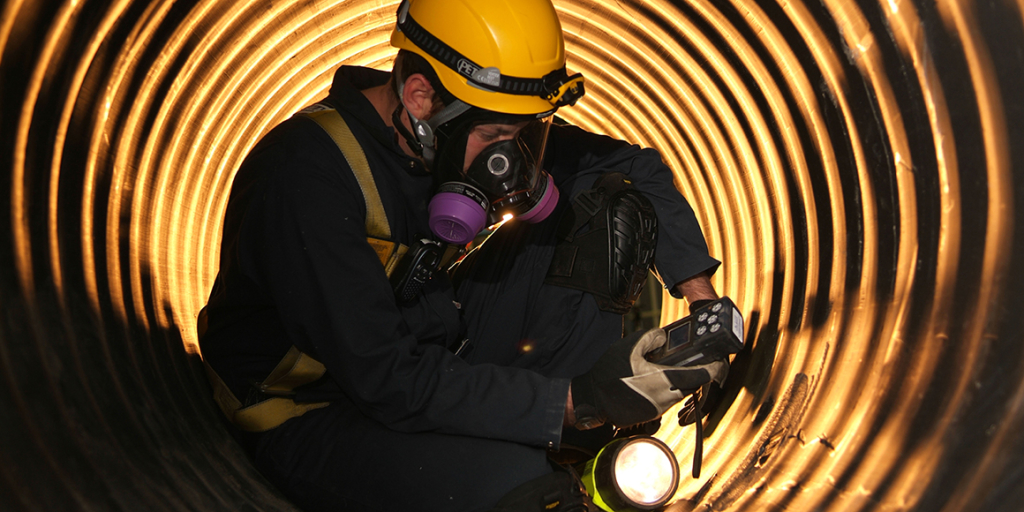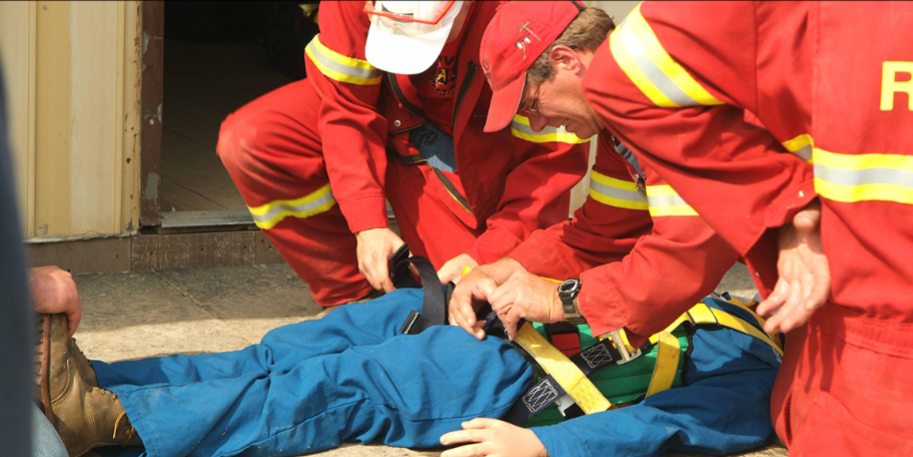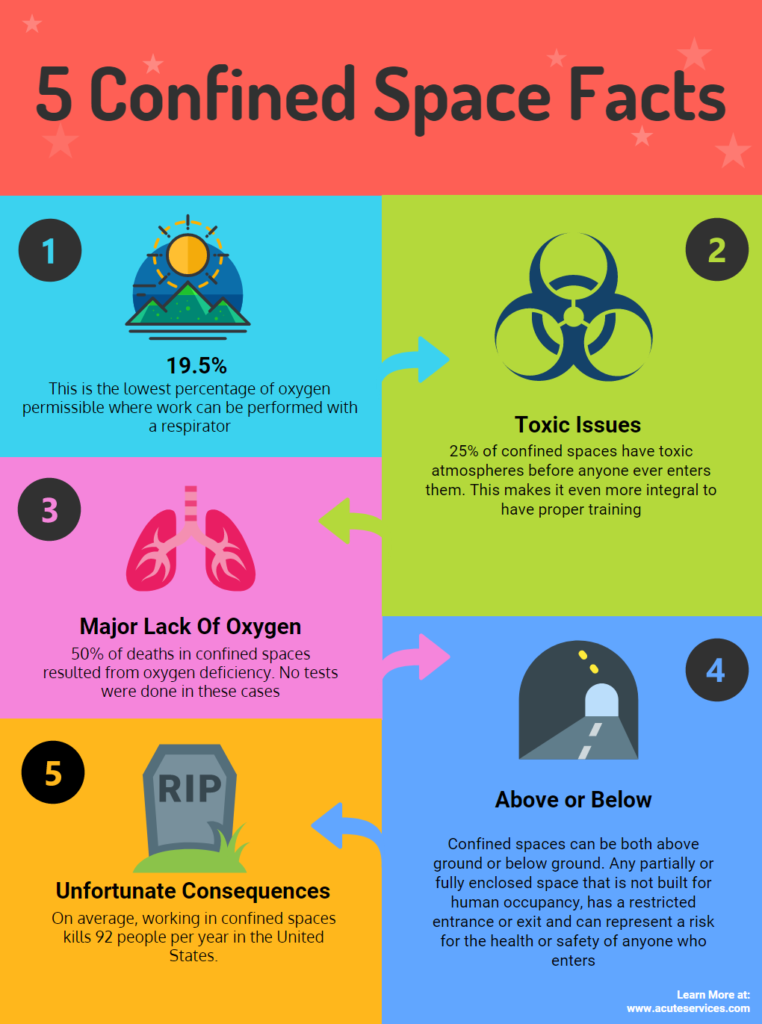Confined Space Training Ontario: Today, we going to take a closer look at confined space training for your workers who must work in high risk confined space areas.
Acute has over 100 years of combined experience with in-house or on-site worker environmental and safety training. We want to help you keep your workers safe.
We’ll explain in detail the two Confined Space Training courses we offer as well as the specific regulations regarding this type of training. So, let’s get started.
Confined Space Training Ontario
Confined Space Training is a requirement for anyone in the workforce who has to work in high risk confined space areas. Here at ACUTE, we offer two different Confined Space Training courses: Confined Space Entry and Confined Space Rescue.
On this page, you’ll find information on the courses that we offer, as well as information about the specific regulations in Ontario. If you have questions or comments regarding confined space regulations or training, or you’re looking for a course not mentioned on this page, feel free to give us a call as we would be happy to help.
Note: This page on Confined Space Training Ontario has been prepared as a resource summary and central location for related information to help workplace parties and employers understand some of their obligations under the Ontario Occupational Health and Safety Act (OHSA). It is not legal advice.
Confined Space Training Ontario: Courses ACUTE Offers
1. Confined Space Entry Awareness Training
This course covers:
- Confined space entry accidents
- Regulation 632/05 – Confined Spaces overview
- Statutory and regulatory responsibilities
- Confined space documents
- Recognizing confined space entry hazards
- Assessing risk and Controlling hazards
- Evaluating Control Measures and air quality monitoring
- Ventilation and purging
- Lock-out/Tag-out and rescue planning
This course will equip a participant with an understanding of how to perform as an entrant, attendant or competent person. Participants will also have the opportunity to become familiar with, inspect, and use Confined Space Entry (CSE) access equipment and air quality instrumentation.
Course Length: This course is 8 hours in length. (1 day)

Confined space entry will teach you how to safely enter a confined space
2. Confined Space Rescue
This course covers:
- The Ontario Confined Space legislation
- Protection of personnel from hazards within the confined space
- Size-up of existing and potential hazards in confined space emergencies
- Risk assessment and hazard control hierarchy
- Evaluation of controls and Rescue types
- Plan and implement a confined space rescue operation
- Management of the physical and psychological challenges in confined spaces
- Use of victim packaging devices and proper lifting techniques
- Use of respiratory protection equipment and when such equipment is required for rescue operations
This course builds on the fundamentals taught in the Confined Space Awareness course to cover rescue planning and the use of Confined Space rescue equipment for either non-entry or entry rescue. This course would equip a participant with an understanding of how to perform rescue operations in support of a confined space entry project.
Course Length: This course is 8 hours in length (1 day).

Confined space rescue will teach you how to safely perform a rescue from a confined space
Confined Space Training Ontario: Get the Facts

Be aware of the dangers of working in a confined space and get the proper training necessary
Confined Space Training Ontario: Frequently Asked Questions
Question: Does the Confined Space Entry training course require any prerequisites?
Answer: No. ACUTE’s Confined Space Entry training course has no prerequisites. Confined Space training does not usually have any prerequisite requirements regardless of training provider.
Question: Who should enroll in the Confined Space Entry program?
Answer: This program is designed not only for workers, but also for employers and supervisors who enter or work around confined spaces.
Question: I understand there were recent changes to the OHSA “Green Book.” Were there any changes regarding Confined Space regulations?
Answer: Yes, there have been changes. Confined Space – O. Reg. 346/15, amending O. Reg. 632/05: Changes were made to stay consistent with the amendment of Regulation 888 – “Control of Exposure to Biological or Chemical Agents Regulation.” Visit the MLITSD Notices page for more information.
Question: How do I know when I or another worker has actually entered a confined space?
Answer: Qualifications of a confined space have to do with the “breathing zone.” The breathing zone is defined as an area within a 10 inch radius of a workers nose and mouth. You or other workers have entered a confined space when the breathing zone around you “break[s] the plane of the opening to the confined space.”

Get the right training to stay safe in a confined space
Question: What is supposed to happen when work is being done in a confined space? What are my responsibilities?
Answer: When work is currently happening in a confined space, there should be warning signs in place to alert others and prevent unauthorized entry into the confined space. If you are working in a confined space, you must constantly be aware of changing conditions within the confined space. If there is danger, workers should leave immediately. For more detailed information, click here.
Question: How important is worker training? As an experienced worker, do I really need it?
Answer: Training is extremely important for both new and experienced workers! Appropriate hands-on training is the best way to ensure proper understanding of confined spaces. Training is just as important for experienced workers, as experienced workers can act as great role models to newer employees by modelling proper safety practices.
Question: Does my Confined Space training last forever? Does it expire?
Answer: It is recommended that the course be taken every three years. Once you have the certification, however, future attendance is up to company policy.
Confined Space Training Ontario – Legal Requirements For Employers
You need to develop a written confined space program for confined spaces in your workplace. There are three parts to a confined space program:
- Part one: Recognize or identify a confined space
- Part two: Assess the confined space hazards
- Part three: Control the hazards by developing a plan for the confined space, providing general training for workers, and creating a permit system.
Refer to the Confined Space Guideline on the Ministry of Labour, Immigration, Training and Skills Development’s website for additional information on how to recognize and assess your confined space, and on how to create your confined space plan.
Confined Space Training Ontario: Definition of a Confined Space
A confined space means a fully or partially enclosed space
- That is not designed nor constructed for continuous human occupancy
- In which atmospheric hazards may occur because of its construction, location or contents, or because of work that is done in it
Examples of potential confined spaces include:
- Tanks, drums
- Tank cars, holds
- Manholes, sewers, shafts
- Silos, bins, hoppers
- Tunnels, culverts
- Vaults, lockers
- Cellars, pits
- Vats, tanks, vessels, tubs
- Ditches, wells, walls, pits
- Pipelines, ducts
Is There A Difference Between A “Restricted Space” And A “Confined Space”?
Yes. Only the Regulation for Health Care and Residential Facilities (O. Reg. 67/93) speaks of a “restricted space” in section 42. In this regulation, a restricted space refers, in part, to a “space from which the egress of a worker is restricted, limited, or impeded.” A “restricted space” may also be a confined space, thus, an evaluation of the space may determine that the area is either a confined space, a restricted space, or both.
Source: http://www.labour.gov.on.ca/english/hs/pubs/confined/cs_4.php
ACUTE – Helping You Work Safe!
With over 100 years of combined industry experience, you can trust that with ACUTE, you will experience only the best comprehensive and hands-on Confined Space training. Here are some ways that ACUTE goes beyond government compliance in Ontario health and safety training.
- Open Door Instructor-Student Partnerships: ACUTE’s training services emphasize client participation. Staff foster relationships with clients and serve as a touchstone for advice moving forward.
- Serving Your Team and Industry: With a vast array of clients in the manufacturing, construction, health, academic, and government sectors, ACUTE brings the best safety practices from across the spectrum to your workplace.
- 100 Years Combined Experience: ACUTE provides comprehensive health and safety training, on-site safety services, and consulting services. With over 100 years of combined experience, our staff offers more than theoretical or abstract ideas. ACUTE offers solutions.
- Track Record of Success: ACUTE is rated 4.9/5 stars on Google reviews, demonstrating a commitment to our clients, quality, and a passion for training.
“We use ACUTE for all of our training requirements. They have excellent
instructors and a great facility.”

